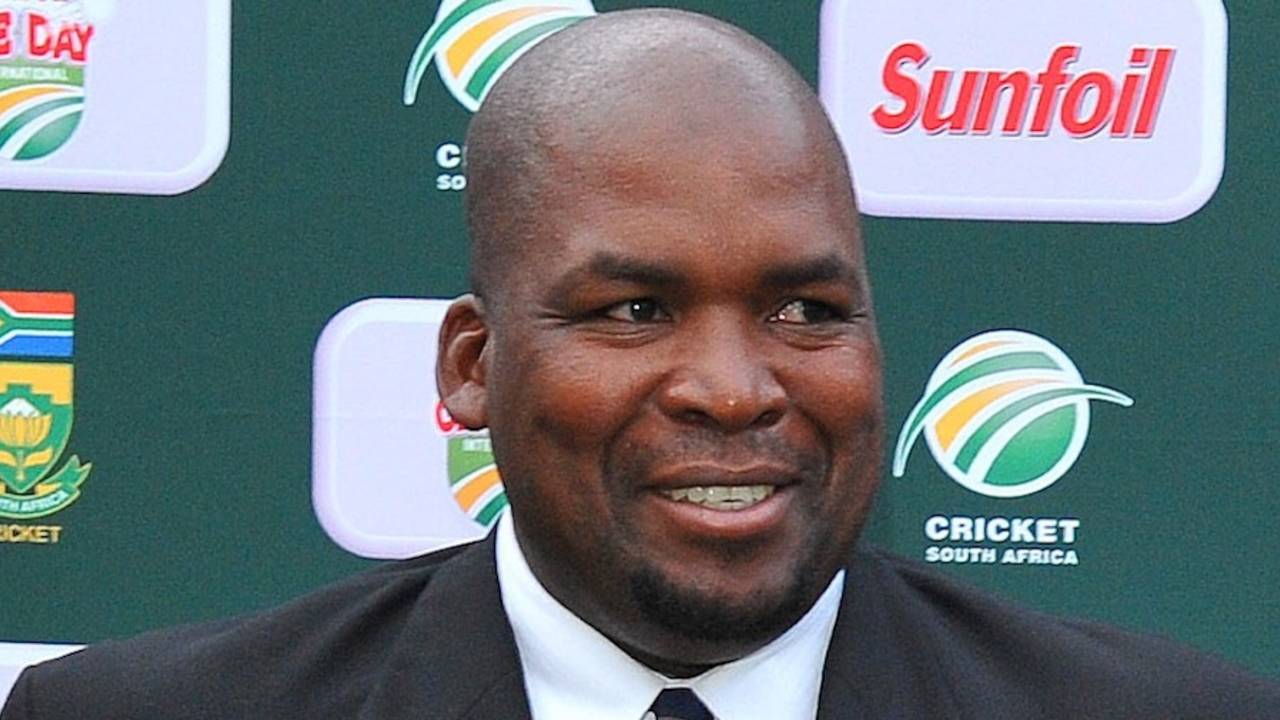CSA commits to transformation goal before parliament
The South African national team has a target to be 50% transformed, although neither the definition of the word nor a deadline has been clarified by Cricket South Africa
Firdose Moonda
19-May-2015
CSA president Chris Nenzani admitted that transformation had taken a back seat for administrators after the emergence of Makhaya Ntini • Gallo Images
The South African national team has a target to be 50% transformed, although neither the definition of the word nor a deadline has been clarified by Cricket South Africa, who presented a report before the country's parliamentary portfolio committee on Tuesday.
The policy of transformation, broadly understood to be the process of correcting the imbalances of South Africa's racially segregated past by providing opportunities to previously disadvantaged people, was the major subject of discussion, as CSA outlined its commitment to change, which made up a significant part of the board's 37-page report.
In it, CSA stated that "transformation remains paramount in the general business of cricket and we acknowledge the progress still required to improve representivity (sic) especially at national level." They noted a "specific focus on increasing black African players" whose progression has stagnated since South Africa's readmission.
While CSA cited high unemployment, poverty, low levels of facilities at rural schools and the high cost of maintaining those facilities as impediments to transformation, president Chris Nenzani admitted transformation also took a back seat as administrators stopped looking for promising players after they found their first flagbearer, Makhaya Ntini.
"Over the past 20 or so years, we relaxed and that is why we had only Makhaya Ntini making a strong claim for the national team," Nenzani said.
To address that imbalance, CSA will introduce new quotas in the 2015-16 season. National representative schools teams* will be required to have eight black African players in a squad of 15, while national representative university teams three black African players in the playing XI. Both provincial and franchise teams must have at least six players of colour in the teams from next summer, of which at least two must be black African.
Nenzani maintained that there was no quota for the national side. "We don't set targets, we give guidelines. A player gets into the national team not because he is black. He needs to be a good player first."
The "guidelines" over national team selection were recently in the spotlight in the aftermath of the World Cup 2015 semi-final, when it emerged that CSA CEO Haroon Lorgat had been consulted on the team make-up and reminded the selectors of the transformation targets of four players of colour in the team. The controversy erupted after Vernon Philander, who had played much of the tournament with a hamstring injury, was picked ahead of the in-form Kyle Abbott.
Despite CSA's admission that Lorgat "impressed on the convener and coach the need to properly consider the best XI bearing in mind the transformation guidelines", theboard insisted there had been no interference from outside sources and called the media coverage of the incident "mischievous."
One member of the parliamentary committee, Samuel Mmusi, said, "If that interference was made in the name of transformation we would support it." Another, Mncedisi Filtane, questioned why Aaron Phangiso, the only black African member of South Africa's World Cup squad did not play a single game: "Phangiso did not even play a single game but there is no outcry about that. We can't just say 'no quotas' when they are in our policy regulations."
Nenzani defended Phangiso's omission when he said, "The only game we are playing is cricket. The only level of target we have not specified is at national level." The committee also demanded more detailed plans from CSA about its transformation goals.
"This is a high-level presentation but where are the programs? You have deliberately withheld them. Why are you withholding this information? What game are you playing with us? Where is the meat?" Filtane asked. He also questioned whether CSA would enter into "sponsorship agreements that include transformation and if not, why not?" and how the board is explaining transformation to white players.
"How do you handle the resistance of white players when it comes to transformation? It's bread for some and less bread for others? You have not committed to any dates," Filtane said.
Lorgat explained that CSA has to "be careful" with "conditional sponsorships" while the delegation confirmed that all players have embraced the need to transform. CSA will meet to discuss a memorandum of understanding with South Africa's sports minister Fikile Mbalula "soon" with all indications that it will decide on a timeline to meet its transformation targets.
The other aspects of CSA's discussion included an overview of their financials in which they revealed a profit of R199,410 million (US$16,716 million) for the 2013-14 season, down R332, 685 million (US$27,050 million) from the season before. However, CSA had initially projected a loss for the season, following the curtailed India tour, and declared the results "excellent."
CSA is optimistic about remaining in the black in future and provided parliament with the ICC's proposed distribution for 2015-2023 as proof. The model shows CSA as the fifth highest earner behind India, England, Australia and Pakistan. CSA is forecast to earn US$93 million from the ICC in that time. By contrast, the BCCI is expected to benefit to the tune of US$568 million.
*1340 GMT, Wednesday, May 20, 2015. The article has been amended to reflect that the quotas for schools and university teams are applicable for national representative teams
Firdose Moonda is ESPNcricinfo's South Africa correspondent
